by Marcela M. | Jul 4, 2012 | Blog, Europe, Main courses, Recipe Box, Recipes, Salads and dips, Savories, Travel, Uncategorized
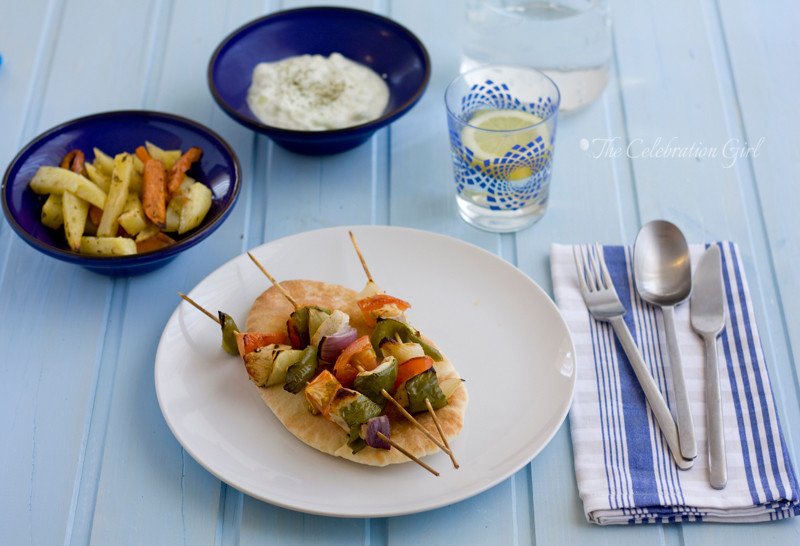
Good afternoon dear friends!
I hope you are having a lovely week! I hadn’t planned to take time off blogging but life took over my plans, and I had to attend to more urgent matters, which is why these recipes are being published late.I had originally planned to bring them to you on Monday the 18th of June (which was the official publication day for savory recipes at Circulo Whole Kitchen) but, as mentioned above, it was not possible. I didn’t want to miss the opportunity of publishing them, however because June’s proposal is very special to me, and because all flavours are summery and ideal for barbecues and outdoor entertaining.
During the month of June, Circulo Whole Kitchen’s savory proposal included three recipes which constitute a traditional Greek meal…and since I live in Greek Cyprus, they are a big part of my life and of my memories of this place . I have already shared one of these recipes with you, that of Tzaziki salad, and for the rest of the menu (which even included freshly baked pitta bread!), I used flavour combinations and marinades that I learnt here. It is my way of bringing you a part of my newly adopted culture, and my children’s first one.
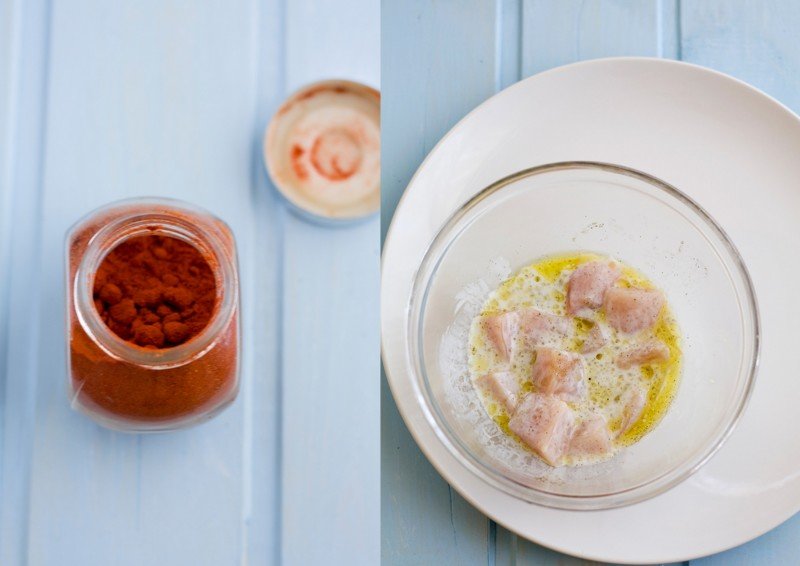
The first time I came to Cyprus was in August 2007, to visit my husband. At the time, I was still working in Ivory Coast (where we had met), and he had arrived to Nicosia a month before. I was meant to join him by the end of the year but we didn’t want to spend 6 months apart, so I took 10 days of vacations and came to see him during the summer. During weekdays, when he was at work, I would stroll the empty streets (Nicosia is a ghost city in August) and, on weekends, we would travel around the island, to get to know our new home. We visited Paphos, Limassol, Larnaca, Aphrodite’s birth place, Kakopetria and other places in between and we were captivated by the calm, quiet, leisure-like mood of the island.
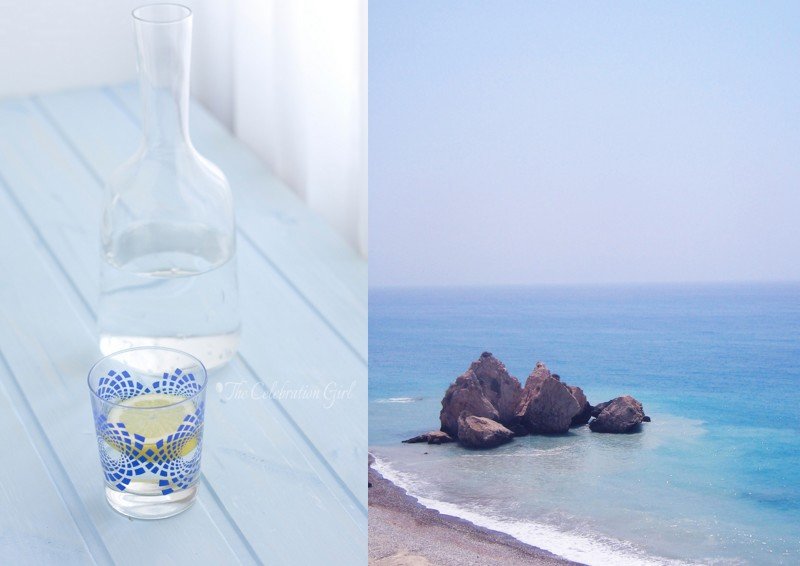
An important part of exploring a new place is, of course, tasting its food, and some of the foods we tasted were the ones that are the object of this post. Now, I had tasted souvlaki before, of course. We call them brochettes in Argentina, using the french word, and I had also had them as kebabs in Ivory Coast (called after their arabic denomination, which means “roast meat”) but the difference lied in the sauces used for marinating them. Until then, I was used to simply brushing meat and vegetables in olive oil and adding rosemary or thyme, or just lemon, and here were marinades that involved wine, cinnamon, yogurt, and french fries served with oregano. I was fascinated and remember scribbling the ingredients mentioned in the menu in paper napkins to try to emulate the recipes at home.
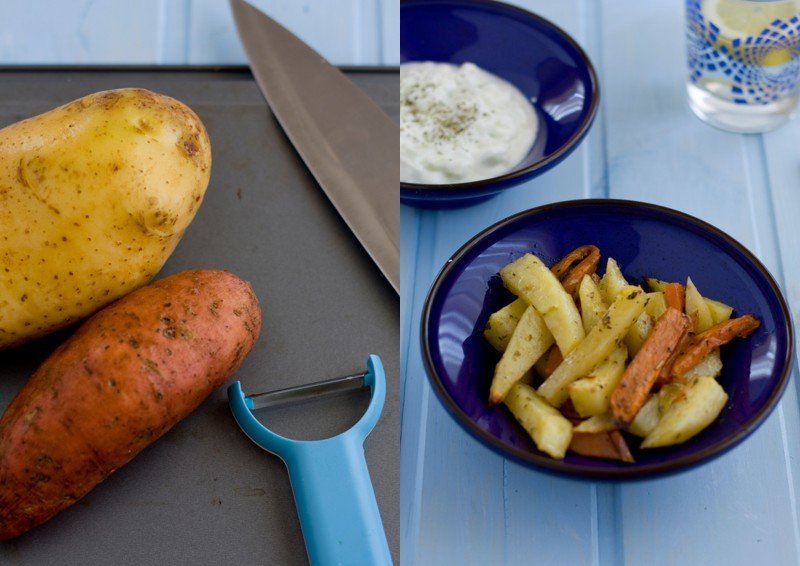
It is through experimenting with the recipes and comments generously provided to me by the people that came into my life since I arrived to Cyprus that I ended up with the chicken marinade for this souvlaki. I accompanied them with traditional tzatziki (using the recipe that my sister in law shared with me many years ago), and with oven- roast mixed potatoes, brushed in olive oil and sprinkled with oregano. For the pitta bread, I used the recipe provided by Circulo Whole Kitchen.
Here are the recipes:
Souvlaki:
Ingredients (for 8 sticks): 3 tablespoons greek yogurt, 3 tablespoons olive oil, 1 clove of garlic, crushed, 2 teaspoons paprika, salt and pepper to taste, 1 big chicken breast, 1/2 green pepper, 1 tomato, 1/2 red onion, 1/2 white onion, .
Preparation:
1) Mix yogurt, olive oil, garlic, paprika, salt and pepper in a bowl. Dice the chicken breast and add the pieces to the yogurt marinade. Cover with cling film and leave in the refrigerator a minimum of 5 hours (preferably overnight).
2) Dice the vegetables and set aside. Remove the marinating chicken from the refrigerator and start assembling the souvlaki, mixing meat and vegetables. Place them side by side on a baking dish brushed with olive oil and pour any remaining marinade over them.
3) Grill or cook in the oven until ready.
Pitta bread:
Ingredients: 500 grs all purpose flour, 2 teaspoons salt, 2 tablespoons olive oil, 240 ml warm milk, 240 ml warm water, 25 grs fresh yeast.
Preparation:
1) Mix flour and salt. Set aside.
2) Mix milk and water and pour over the yeast, mixing until dissolved
3) Add the the liquid mix to the flour and incorporate. Work the dough thoroughly, until really smooth and soft (this is important! do not skip this step!)
4) Form a ball of dough, place in bowl, cover with cling film and let it rest until it doubles its volume.
5) Flour the counter, put the dough on it, and pat it against the counter a couple of times, in order to remove air.
6) Cut the dough in small portions, cover with a kitchen towel and let them rest for about 15 minutes, in a warm place.
7) Once the small portions of dough have risen, roll them to give them a circular shape, until they are 1/2 cm thick. Place them in baking sheets, cover them and let them rise again.
8) Once risen, cook in a hot oven (220C) for about 6-10 minutes. They should not brown, only be crispy on the outside. Store them one on top of the other, covered with a kitchen towel for maximum freshness.
Oven-roast mixed potatoes:
Ingredients: 1 big potato and 1 big sweet potato, olive oil, oregano
Preparation:
1) Peel and cut the potatoes alongside (as if you were making French fries)
2) Place them on a roasting pan, and brush them with olive oil.
3) Mix salt with one tablespoon of oregano and sprinkle over the potatoes. Cook in the oven until just tender.
Tzaziki (originally published in this post)
Ingredients: 1 cucumber, 1 clove of garlic, greek yogurt and a little bit of parsley for garnishing.
Preparation:
1)Cut the cucumber into thin slices, and then chop them finely. Place them in a bowl.
2)Chop a clove of garlic (or half, if you are not a very garlicky person) and add it to the cucumber.
3) Add greek yogurt (500 ml) and mix well.
4) Chop a few parsley leaves to garnish.
Con sabor latino...
Buenas tardes queridos amigos!
Espero que esten pasando una hermosa semana! No había planeado tomarme vacaciones del blog y tardar tanto en publicar pero la vida se interpuso en mis planes y tuve que ocuparme de asuntos más urgentes, motivo por el cual estas recetas se publican recien hoy. Mi idea original era publicar este post el 18 de junio (ups!), que era el día oficial de publicación de las recetas del Circulo Whole Kitchen, pero, como mencioné anteriormente, lamentablemente ésto no fue posible. Elijo publicarlas, sin embargo, aún cuando haya pasado tanto tiempo, porque la propuesta del Circulo Whole Kitchen para el mes de junio tiene una importancia especial para mí, y porque todos los sabores incluidos son muy veraniegos, ideales para asados y reuniones al aire libre.
En el mes de junio,el Circulo Whole Kitchen nos invitó a preparar tres recetas tradicionales griegas…y como yo vivo en la parte griega de Chipre, estas recetas forman parte de mi vida diaria, y estos sabores forman parte de los recuerdos de esta tierra adoptiva que llevaré conmigo a donde vaya. Una de estas recetas (la de tzaziki), ya la compartí con ustedes en ESTE POST, pero la repito aquí para que no tengan que andar buscando en los archivos (aunque buscar en fácil ahora, no? 😉 Para el resto del menú, utilicé combinaciones de sabores y marinadas que aprendí aquí. Esta es mi forma de acercarles una partecita de mi cultura de adopción- y la primera de mis hijos.
La primera vez que vine a Chipre fue en agosto de 2007, para visitar a mi marido. En ese tiempo yo aún estaba trabajando en Costa de Marfil (donde nos habíamos conocido) y él había llegado a Nicosia un mes antes. Ya habíamos decidido que yo me le uniría aquí definitivamente a fines de ese año, pero 6 meses nos parecía demasiado tiempo para estar separados, así que yo vine a visitarlo durante 10 días en el verano para acortar el tiempo a la distancia. En esas vacaciones comenzamos a conocer la isla. Los días de semana, mientras él trabajaba, yo paseaba por las calles desoladas de Nicosia (que es una ciudad fantasma en agosto!) y, los fines de semana, explorábamos el que sería nuestro nuevo hogar. Así visitamos Pafos, Larnaca, Limassol, la roca donde nació Afrodita, Kakopetria y otros lugarcitos, y quedamos cautivados por el animo veraniego, calmado, tranquilo de la isla.
Una parte importante de explorar un lugar desconocido es, claro está, probar sabores nuevos, y algunos de esos sabores nuevos para mí son los que incluyo en este post. No, no es que haya probado souvlakis por primera vez en este viaje, de hecho en Argentina los llamamos brochettes (usando la palabra francesa) y tambien los había comido en Costa de Marfil (donde los llaman kebabs, usando la palabra árabe, que significa “carne asada”), pero la diferencia estaba en los condimentos utilizados y en la forma de emplearlos. Antes de venir a Chipre, cuando yo hacía brochettes no marinaba la carne, sólo la pincelaba en aceite de oliva y espolvoreaba romero o tomillo o, simplemente, limón…y de pronto aquí me encontraba con marinadas que utilizaban vino, canela, yogurt, paprika y las papas fritas se servian espolvoradas con oregano. Estaba fascinada con los nuevos descubrimientos culinarios, y anotaba los ingredientes que leía en los menus en servilletas de papel para hacer pruebas en casa, e intentar emular las recetas.
La marinada que usé en estos souvlaki de pollo fue producto, justamente, de esos experimentos nacidos de los comentarios generosos y de las recetas que me brindaron personas que aquí conocí. Los serví sobre pan de pitta casero y los acompañé con la tradicional tzaziki (hecha con la receta de mi cuñada) y con papas y batatas rostizadas al horno, pinceladas en aceite de oliva y espolvoreadas con sal oreganada. Espero que les gusten!
Aqui estan las recetas:
Souvlaki:
Ingredientes (para 8 palitos) : 3 cucharadas de yogurt griego, 3 cucharadas de aceite de oliva, 2 diente de ajo machucado, 2 cucharadas de te de paprika, sal y pimienta a gusto, 1 pechuga de pollo grande, 1/2 pimiento morrón verde, 1 tomate, 1/2 cebolla colorada, 1/2 cebolla blanca
Preparacion:
1) Mezclar en un bowl yogurt, aceite, ajo y paprika. Cortar el pollo en cubos y agregar a la marinada de yogurt. Cubrir con papel film y dejar reposar en la heladera un mínimo de 5 horas (preferentemente toda la noche)
2) Una vez transcurrido el tiempo indicado, cortar los vegetales en cubos y retirar el pollo de la heladera. Armar los souvlaki cuidando de intercalar distintas verduras con la carne. Una vez armados, colocarlos en una placa para horno pincelada con aceite de oliva y verter encima todo restante de marinada.Llevar a horno mpderado a fuerte hasta que estén cocidos.
Pan de pitta (receta de Circulo Whole Kitchen)
Ingredientes: 500 gr de harina, 2 cucharaditas de sal, 2 cucharadas de aceite de oliva, 240 ml. de leche tibia, 240 ml. taza de agua tibia, 25 gramos de levadura fresca
Preparación:
1) Poner en un bol la harina junto con la sal.
2) Mezclar la leche con el agua e incorporarla a la levadura mezclando hasta disolverla. Agregar esta mezcla a la harina, poco a poco, junto con el aceite de oliva e ir mezclando hasta que esté todo el líquido incorporado.
3) Formar una masa y comenzar a trabajarla en forma continua hasta que esté bien lisa y suave. Es importante que la masa esté bien amasada.
4) Colocarla en un recipiente y cubrirla con un plástico y dejarla levar hasta que doble su volumen.Una vez levada la masa se vuelca sobre una mesa enharinada.
5) Desgasificar la masa y cortar en porciones que se dejan descansar sobre una superficie enharinada y cubiertos con un paño. Preferentemente en un lugar cálido. Esto hará que nuestro pan leve en aproximadamente 10 a 15 minutos.
6) Se toma cada porción y se estira de medio centímetro de espesor en forma circular o alargada. Se van depositando en placas limpias, se cubren con un paño y se dejan levar nuevamente.
7) El secreto de estos panes es cocinarlos en un horno a una temperatura alta , unos 220º, para que se inflen y formen corteza pero sin color, deben quedar blancos. Los dejamos hornear durante unos 6 a 10 minutos.
8) Para conservarlos blandos se apilan unos sobre otros en caliente y se cubren con un paño, o plástico.
Mix de papas y batatas oreganadas al horno:
Ingredientes: 1 papa grande común, 1 batata, aceite de oliva para pincelar, oregano para espolvorear
Preparacion:
1) Cortar las papas en bastones, como si fueran papas fritas.
2) Colocar las papas en una fuente de horno y pincelar con aceite de oliva.
3) Mezclar la sal con una cucharada de oregano y espolvorear sobre las papas. Cocinar en horno moderado hasta que esten tiernas.
Tzaziki:
Ingredientes: 1 pepino, 1 diente de ajo (o medio, si no quieren espantar vampiros ;), yogurt griego (o yogurt natural, si no encuentran), perejil para espolvorear arriba antes de servir
Preparación:
1) Cortar en pepino en rodaja bien finitas, y luego picarlo hasta que quede chiquito.
2) Picar el diente de ajo muy finito.
3) Agregar el yogurt y mezclar bien.
4) Antes de servir, picar unas cuantas hojas de perejil y espolvorearlas encima.
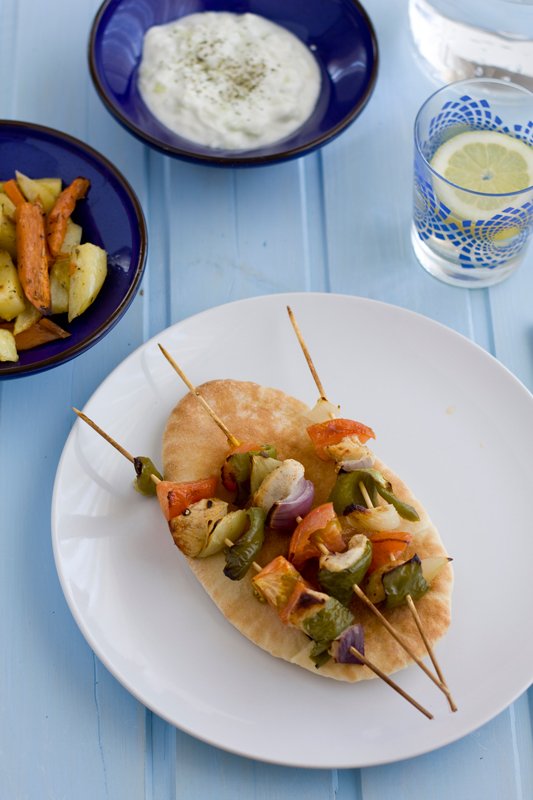
I hope you like these recipes!
What is the dish that spells summer to you?
PS: Happy 4th of July to all my American followers! May you be enjoying a wonderful day with family and friends!
by Marcela M. | May 16, 2012 | Blog, South America, Travel, Uncategorized
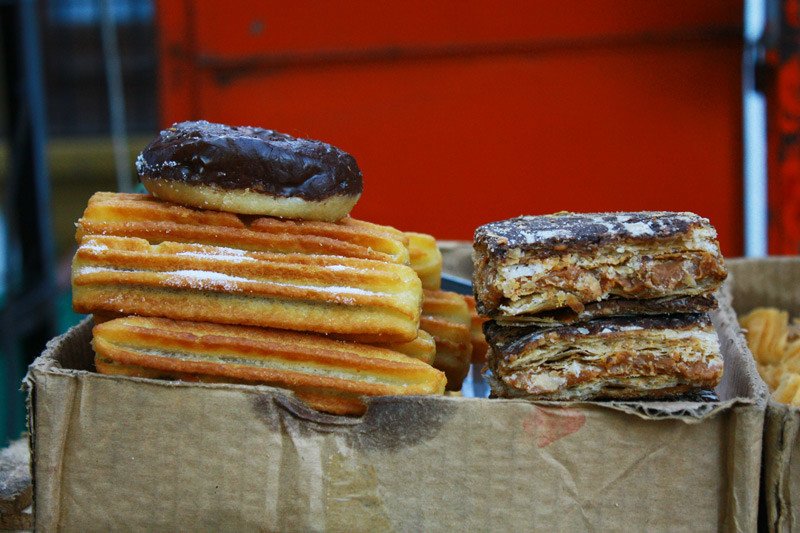
Good morning friends! I hope you are having a wonderful week!
This is the last post on Argentinian sweets…well, not the very last one I will write, because I plan to bring you some recipes, but the last one of this introductory series. Starting from the next post, I will resume my regular posting of recipes, crafts and party ideas.
This post does not have many pictures and the ones it has were taken on the streets of Buenos Aires, whenever I could find local vendors selling the things I wanted to talk to you about ( this is just to show you how popular they are). Two extremely popular cakes are missing from the pictures, but I will provide you with links that have beautiful pictures, so that you can have an idea of what it is I am describing.
Let’s begin with a Latin American classic: churros! We used to eat them to accompany hot chocolate on winter days, home-made by my mother or my grandmother (who even had a “churrera”, which is the cylinder shaped machine to make churros with the traditional scalloped border). When I visited Punta del Este, in Uruguay, I tasted them filled with dulce de leche or chocolate for the first time. Later, chocolate, dulce de leche or cream filled churros became very common in Argentina as well, and now we can say they have become a popular favourite.
Milhojas de dulce de leche (pictured next to the churros, above, and here) is none other than a “dulce de leche thousand layer cake”: a cake made with layers of “hojaldre” (which is similar to puff pastry) stuck together with lots and lots of dulce de leche repostero and covered in either dark chocolate or poured fondant (more commonly, the former). It is a traditional cake for birthdays and small versions can be bought at almost any bakery.
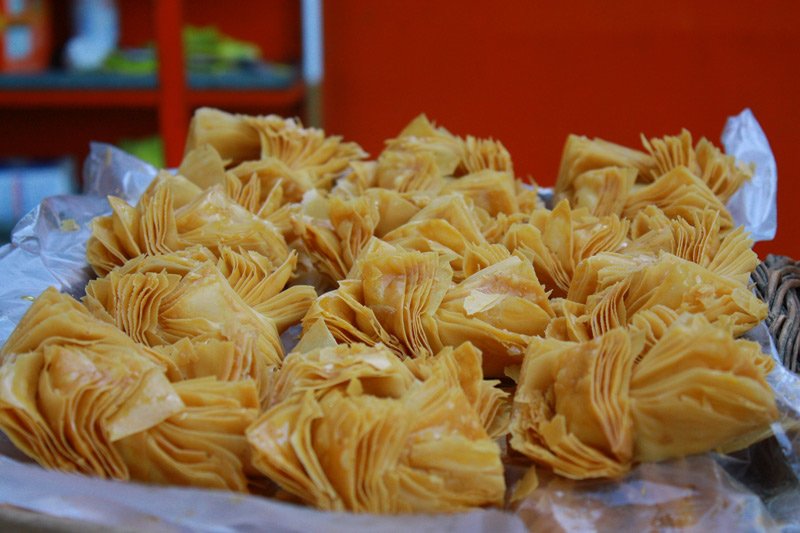
Pastelitos (pictured above) are the sweets that are traditionally eaten during national holidays (25th of May, Argentina’s first national government day, and 9th of July, Argentina’s Independence day). They are made with a variation of puff pastry and traditionally filled with quince spread or sweet potato marmalade, though it is also possible to find them filled with (you guessed it!) dulce de leche or dulce de leche and walnuts. Once they are assembled, they are deep fried in either oil or grease, until golden.
Other two VERY popular cakes are Rogel Cake and Chocotorta. Rogel cake is made layering sheets of cake of a texture similar to the one of alfajor santafesino with dulce de leche repostero, and topped with Italian Meringue. It is extremely sweet, but delicious!
Chocotorta is a childhood classic which dates from the 1970’s, when a popular plain chocolate cookie brand (chocolinas) boosted its sales by advertising a simple cake that kids could do themselves using said cookies, because no baking was involved. The cake is made by layering chocolinas with dulce de leche (of course) mixed with cream cheese (queso blanco/fromage blanc), and it tastes delicious after 24 hours in the fridge, because the cookies fully absorb the filling and they become unrecognizable. Some people dip the cookies to moisten them more, either in coffee, syrup or dessert wines such as marsala or oporto. The cake is commonly covered with the same dulce de leche and cream cheese mix, and topped with chocolate swirls or simply cocoa. The cake is so popular that restaurants started serving it (see this article on the best chocotortas in Buenos Aires restaurants, for example) and couples started requesting it as wedding cake.
I hope that you enjoyed this series of posts on Argentina’s food culture. In the next post we will go back to our regular themes: recipes, parties and crafts.
Have a wonderful day!
by Marcela M. | May 10, 2012 | Blog, cookies, Recipe Box, Recipes, South America, Sweets, Travel, Uncategorized
Good evening dear friends! I hope you had a lovely week.
This week, we continue with our introduction to typical Argentinian sweets, the ones we, Argentinians, love and miss when we are abroad. Today, I bring you some of my favourite bite-sized sweets. All of them, except branch chocolate and nuts confit, can be found in any kiosk, so they are great for an almost guilt-free sugar rush moment. Also, all of them, except for “bocadito maroc” include dulce de leche, because most of my fellow country-men would agree that “a desert without dulce de leche is not desert”. I have changed quite a bit in this regard since living abroad, but try baking a birthday cake with buttercream, jam or lemon curd for an Argentinian child (or adult!) and you will be met with a face of sheer disappointment!

Let’s begin with Bocaditos Maroc, which are the bi-colour squares portrayed in the pictures above. They are made with a combination of peanut cream, milk and white chocolate. They are soft and truly melt in your mouth and, best of all, they are really easy to make at home so, if you want to give them a try, here’s how: Cover a square pan with foil. Process 100 grs of peeled roasted peanuts with 1 tablespoons of corn or canola oil until it reaches a pancake batter consistency. Melt 100 grs of milk chocolate and add 1/3 of the peanut cream to it. Mix well and place it in the pan, making sure it covers the pan evenly and smoothly. Bring to the fridge for about 15 minutes, so that the chocolate hardens. Melt 80 grs white chocolate and add another 1/3 of the peanut cream, mix well and pour it on top of the milk chocolate and peanut mixture. Put it in the fridge for another 15 minutes and, in the meantime, melt the remaining 100 grs of milk chocolate. Mix with the last 1/3 of peanut cream, and add it to the pan. Smooth the top with a spatula and place it in the fridge until hard. Once ready, remove from the pan, peel off the foil and cut into squares with a sharp knife (If you wet the knife in hot water, it will be easier to get a nice, clean-cut). And that’s all it takes!
The following treat is perhaps the most common of them all: Dulce de leche cones, or “Pinitos de dulce de leche”. They are simply, as you can see from the picture below, a truly decadent treat made of cookie, lots of dulce de leche disposed in a cone shape and covered in either dark or white chocolate.

If you live outside of Argentina and you are familiar with regular dulce de leche, you may be wondering how it is possible for the cones to keep their shape. The answer is this: the cones are not made with regular dulce de leche, but with dulce de leche repostero, or “baking dulce de leche”, which is firmer and thicker than the regular one (which has a jam-like consistency).
Dulce de leche repostero, unlike regular dulce de leche, is not made solely of milk, sugar and vanilla. Now, be warned, here comes a big surprise: Dulce de leche repostero has bean pulp (pulpa de frijoles) and cornstarch to give it its consistency. Argentinian friends, if you don’t believe me, go check the ingredients listed in a can…I did it back in November and couldn’t believe my eyes!
If you want to make it at home, you should know that the proportions are different from the ones for regular dulce de leche: apart from adding the above ingredients, it takes three times more sugar. So, for every 5 litres of milk (as I did in the original recipe), you will need 3 kg of sugar, 2 1/2 cups of bean pulp (made soaking the beans overnight, then boiling them until very soft and finally passing them through a sieve), 10 tablespoons of cornstarch, 1 vanilla bean and 1 tablespoon of cornstarch. The procedure is pretty much the same as for regular dulce de leche, except for the addition of the beans which has to be done after the milk and sugar mixture starts to thicken (see the first stage of browning of my earlier post on dulce de leche). Right after adding the bean pulp and mixing everything very well with a wooden spoon, you should also add the cornstarch previously diluted in half a cup of cold milk. Then let time run its course and after a few hours you should be able to enjoy wonderful baking dulce de leche!
Another special treat that I look forward to eating when I go home are nueces confitadas, or “nuts confit”:


There are many recipes and ways to make them, but most of them involve three ingredients: dulce de leche repostero (see why you should know how to make it? 😉 , walnuts and poured fondant. The most traditional way consists of surrounding a full walnut in a spoon of dulce de leche and covering it all with poured fondant. Some, however, do it in a different way (as the ones that you can see in the picture above), which consists in making a paste with dulce de leche repostero and processed walnuts, giving it a ball shape and covering each ball in either poured fondant or dark chocolate.
The following picture shows another personal favourite, called Bocadito cabsha:

They are made with host capsules (yes, like the host of catholic mass. In Argentina they can be bought at baking supplies stores), dulce de leche, glucose, rum, and chocolate. The procedure is very simple: you need to heat the glucose in a pan, together with the dulce de leche, remove the pan from heat and add the rum, and fill the capsules with this preparation being careful not to overflow them. Finally, cover the capsules in chocolate, let them cool down for it to harden and enjoy!
Finally, chocolate en rama, or branch chocolate:

If you are curious about how it is made, check this video where you can see a real maitre chocolatier at work.
See you next week, with the last post on Argentinian sweets and a few recipes!
Have a wonderful weekend!
by Marcela M. | May 3, 2012 | Blog, cookies, Recipe Box, Recipes, South America, Sweets, Travel, Uncategorized

Good morning friends! Let’s finish the week on a sweet note, shall we?
Last year, during our stay in Córdoba, I started preparing a few posts about Argentina’s sweet food culture. I could not finish writing these posts at the time, but I did take the pictures with the aim of showing you what we, Argentinians, think about when we think about sweets, what we love, what we miss when we are abroad. So here is the first of these posts, three in total, showcasing a small selection of my favourite treats. I need to give you one warning, though: there are many more sweets that I could not find in Córdoba (because they are typical of other provinces) or didn’t have the time to photograph. I also owe you a post on the candies and cookies from my childhood, which I meant to prepare, but my children kept eating the items to be photographed 😉
So, let’s begin! Today’s post is about the most popular of Argentina’s sweet treats: alfajores. But what are alfajores? And why are they called this way?
Alfajores are basically two cookies sandwiched together by some kind of sweet filling, be it fruit jam, dulce de leche, mousse or even ice cream. Their name comes from the arabic word “alajú”, and it is, in fact, an arabic confection that entered Spain during the Moorish era (during the period of Al-Andalus) and was then adopted -and modified- by the Spanish colonies. The shape and the recipes for the cookie itself and its fillings vary greatly from one country to the other, and even from one region to the other. According to wikipedia, the original confection (which can still be found in Spain) contained flour honey, spices and nuts and had a cilinder form (like a crêpe), while in Latinamerica alfajores are round and are normally filled with jams and mousses.Also, while in Spain they constitute a treat to be enjoyed mainly on special occasions (such as Christmas), except in the Medina Sidonia (where one can buy them all year long), in countries such as Argentina they are an everyday snack and can be bought in any kiosk.
Alfajores are different from a regular sandwich cookie, such as an oreo. The texture of the cookie itself is different: alfajores are moist and soft, and lack the crispiness of a traditional sandwich cookie. The filling is different as well, and more abundant. Whoopie pies, on the other side, look like an alfajor, and that is probably what we would call them back home in Argentina.

Argentina has different kinds of traditional alfajores, which differ from province to province. There are, of course, those that are available in kiosks nation-wide, produced by big candy companies, such as Arcor, Bagley or Terrabusi (owned by Kraft foods), but what is really interesting, and what I recommend you to do if you travel to Argentina one day, is to taste the regional versions, and compare them. In the following pictures I will show you some of these alfajores for you to get a glimpse at the variety you can find, and once I have tested and tweaked the recipes I brought from home, I will share them with you here as well.
The first type of alfajores I am showing you is perhaps the most famous one: Alfajor “Marplatense”, the alfajor from Mar del Plata, a seaside city in Buenos Aires province, which is also a traditional vacation spot.

Mar del Plata has many alfajor factories and, one of them, Havanna, has opened cafés and stores in several other countries, such as Israel, Spain, Mexico and the US. Havanna alfajores can also normally be found in shops that sell Latin-american products, as well as in Argentinian restaurants.
There are several types of alfajores from Mar del Plata: vanilla cookie with dulce de leche filling, covered in chocolate, vanilla cookie with dulce de leche filling covered in sugar glaze, vanilla and coffee cookie with dulce de leche filling and dark chocolate glaze, and vanilla and walnut cookie, with dulce de leche filling and covered in white chocolate glaze. They are all delicious, and their dulce de leche filling has the characteristic subtly smoky flavour that just burst in your mouth with the first bite and leaves you wanting more.



Alfajores from Córdoba are quite different, in two main aspects: the cookie is quite simple and light, the traditional filling is fruit jam instead of dulce de leche (normally, apple, pear or quince jam) and they are covered with a very simple sugar glaze made with only icing sugar and water that does not cover the cookie completely. Due to the popular love for dulce de leche, however, alfajores cordobeses with dulce de leche also exist, but they are not the traditional ones.


The cordobese confection that traditionally carries dulce de leche are colaciones, which are characterized by the crispy, curved nature of the cookie (that contains many egg yolks and a little bit of alcohol in the dough).

Alfajores from Santa Fé are also very popular. They are made of three layers of crispy, rather dry cookie (characterized because the dough has to be rolled and turned on itself 20 times, such as in the procedure for making puff pastry) , filled with dulce de leche (lots of dulce de leche, since the cookie itself is not overly sweet!) and covered with a sugar glaze made with icing sugar, water, lemon and egg whites.

Another very famous alfajor, which I couldn’t find in Córdoba to photograph, is the Alfajor Norteño (from Argentina’s North-West region), which is filled either with layers of dulce de leche and turrón, or only with turrón paste made with honey, egg-whites, sugar and walnuts.
I hope you liked this small introduction to our sweets and, worry not!, recipes will come soon!
And in case you are wondering who ate all those sweets that were photographed, it was a little blonde elf that helps me style food whenever he can…
Have a wonderful weekend!
by Marcela M. | Mar 30, 2012 | Blog, South America, Travel, Uncategorized
I love Buenos Aires.
I thought I should let you know how partial I am about the city before even beginning to write about it, so that you would be warned. Because I am (impartial) and because I do love it very much. True, I have never lived there and I have only visited it as a tourist, but I have always had such a great time and I find it so incredibly beautiful, stimulating and full of life that I can’t imagine NOT liking it for any reason.
The first time I visited I was 7 years old and, when I went back to Córdoba, I asked my mum on the plane back home, full of guilt, why Córdoba was not as beautiful. Since then, I have gone back several times, mostly on short trips, and every time I go I am amazed at how beautiful the city is-at least, for me.
As I mentioned before, I have been to Buenos Aires mostly on short trips, so I explored the city little by little. Back in 2002 to 2004, I used to travel every 15 to 30 days, for 24 hs. I would take the bus at night, and arrive to Buenos Aires at dawn, when shops were opening, cafés were getting their delivery orders of medialunas from bakeries, apartment concierges were washing the sidewalks and streets were beginning to get crowded with cars full of people going to work or taking their children to school. I like watching cities wake up, I find the early hours of the morning very magical so it was a special treat to see a city I love get ready for the day.
In those trips, I would generally have a meeting in the morning and then I would take the rest of the day to explore the city by foot, before taking the bus back to Córdoba. My meetings would generally take place downtown, and from there I would walk wherever I wanted to go that day. This is how I visited museums such as the wonderful Museum of Latinamerican Art-MALBA, or the National Fine Arts Museum , as well as landmarks such as the Recoleta Cementery, the Botanical Garden, the Japanese Garden,and the Floralis Generica.Sometimes I attended free lectures at Universities, or literary gatherings at local cafés, but most of the time, I just took pleasure in strolling the city streets. I never bought anything because I didn’t have any money, nor did I take pictures, because I didn’t have a digital camera (and buying and developing films was expensive) but, to be honest, I didn’t miss either. Being there, surrounded by all that beauty was enough to feed my soul.
Buenos Aires is big, huge even, but I find it very walkable and it is easy to move around using buses or the subway, for longer distances. It is a very green city, with plenty of trees lining its streets, and big parks where people sunbathe in the summer (yes, they do!), run in the afternoons, grab a bite at lunch time or have a picnic during weekends. The city’s rhythm is hectic and everyone seems to be always in a hurry, yet I have always been greeted with a smile (some say I was lucky, but I can only speak from my own experience, which was always positive). Taxi drivers love to discuss politics, to talk and to make recommendations, to ask where one is from and to give their opinion. I find this very funny and always enjoy my taxi rides because of this reason- but I must confess my husband doesn’t find it that amusing (insert smile)
Buenos Aires has plenty of cafés, some of which are important landmarks and are not to be missed, such as Café Tortoni (which is 150 years old) Café de los Angelitos or La Biela (which was my father’s favourite)- so please, avoid the local Starbucks if you are ever there, and get a real “café con medialunas” in a place that feels like Buenos Aires and not like any other café from the same chain in any other city of the World. The local magazine Planeta Joy made a selection of the 10 best traditional cafés of Buenos Aires, if you are ever in the city, which you can find here.
Buenos Aires is also a very cultural city, full of libraries (like the incredibly beautiful El Ateneo Grand Splendid) where it is a pleasure to browse for new and old books alike. The city also has one of LatinAmerica’s most important Opera Houses, the Teatro Colón (which was recently refurbished and restored) and there is always a large offer of theatre plays, concerts, talks, seminars, art expositions and other interesting activities such as philosophical cafés (or café-filo). Musicians and artisans populate the streets and the city is famous for its interesting finds in design and vintage objects.
When we started planning this trip, we had originally envisioned spending a week in Buenos Aires. I had already been there with my husband after we got married, and we were looking forward to showing it to our children. We wanted to rent an apartment, to be able to move freely and to explore the city by bits, so as not to end up with cranky toddlers. Unfortunately, this wasn’t possible. Finding a rental apartment was so hard, and prices so exorbitant that, 3 months before the trip, we gave in and decided to change our tickets to spend a mere weekend there, and we booked a hotel.
In the end, this was the best decision because, 5 weeks already into our trip, Luka and Zoe had become exhausted, wanted to come back home and were in an almost permanent state of crankiness. So we kept our outings really simple, leaving all the explorations for another time and focusing on keeping them happy and meeting a handful of friends only.
We stayed in Recoleta, because of easy access, safety, close friends who live in the area and proximity to parks and museums, and we limited our outings to it (on Saturday) and Palermo (on Sunday). There are many other neighbourhoods we could have visited, and I do know the ones we chose are the two most touristy there are but, when travelling with small children, options are not as large as when one travels alone.
It was early December when we were there and the Spring weather was absolutely delicious, which was great for walking. Luka and Zoe travelled in the double stroller while we walked around, sleeping on occasions, lullabied by the breeze.
One of the places we visited was the Recoleta Cemetery which dates from 1822 and where all Presidents and other important persons such as writers, artists and sportsmen are buried. It was the first and, for many decades, the only cemetery the city had (until the creation of the Chacarita). Its most visited tomb is probably the one of Eva Perón but, to be honest we didn’t visit for the famous names. We visited, instead, because the whole place is a work of art and I find it particularly fascinating to see how a person’s character and taste has been portrayed by its survivors. There are heroes carried by crying angels, militars handing over their swords, journalists being shown their way to heaven by angels, and even couples giving their back to each other because the wife had stopped talking to her husband after a discussion and had requested to be portrayed in this way since “she would still be angry at him after death” (It’s true! Look for the tombs of Salvador Maria del Carril and Tiburcia Dominguez!). In order not to miss the funny anecdotes, it is better to take the official guided tours, but if you don’t have time or money to do so, a simple walk around the place will prove interesting nonetheless.
In the Cemetery’s surrounding area there is also the famous Iglesia del Pilar ( del Pilar Church), the Recoleta Cultural Center, the National Library, several museums (such as the Palais de Glace, the Museum of Fine Arts or the Xul Solar Museum) as well as plenty of restaurants, cafés, shopping malls (such as Patio Bullrich and Buenos Aires Design) and open fairs (during weekends). And if you like (and can afford) high-end shopping, this is your area as well.
On our second day in Buenos Aires, we chose to visit Palermo, mainly because my husband had never been there, and I had been so long ago that I could hardly remember anything.
Palermo is a neighbourhood that has changed a lot in the last 20 years. Different parts of it have been popularly renamed according to their new vibe, and we can now find places known as “Villa Freud” (where there’s the highest number of psychologists and psychiatrists)”Palermo Soho” (the more bohemian side of the city) or “Palermo Hollywood” (where local TV stars live), for example. Unlike Recoleta (which is more conservative), Palermo has an artsy, laid-back feeling. There are artists selling their handicrafts on the streets, independent designer shops, as well as vintage and antique products, some cobblestone streets, and a myriad of cafés with tables on the sidewalks. Palermo is also the neighbourhood where the Japanese Gardens (which has a restaurant where you can order Tea served with the traditional Tea Ceremony), the Zoo and the Botanical Gardens are, as well as the Planetarium and the MALBA.
We kept our day very simple: we strolled around Recoleta in the early morning and then joined a dear friend for lunch at a Lebanese restaurant in Palermo, followed by a quiet walk, and some mandatory ice cream in Un’Altra Volta (seriously, ice cream in Argentina is so delicious it’s a crime not to have as much as one can. I’m not kidding!). By middle afternoon, we joined a big group of friends who had organized a meet up in the Japanese Gardens (travelling even from other provinces). We were around 10 families, with our children, talking,laughing and hugging each other in what was a real goodbye treat and a perfect way to bring our trip to a close.
The following day, we took the plane back to Paris-Belgrade, and two days after that, we arrived back home, to Cyprus. Exhausted but happy for what we lived and happy to be back home as well. Our time in Buenos Aires was short and quiet, but we left knowing that there will be future trips where we will be able to explore other places (like La Boca, San Telmo, Tigre) and to do other fun activities. This trip to Argentina was not about exploring, it was about family and friends and, like that, it was perfect.
Have a beautiful weekend and get ready for some serious sugar rush, because in my next post I will start showing you Argentina’s traditional sweets!
by Marcela M. | Mar 22, 2012 | About, Blog, South America, Travel, Uncategorized
Good morning dear friends! As I promised, here’s my first post about our trip to Argentina.
It was a difficult post to write because, how to describe one’s own city, how to accurately portray it for those who have never been there, how to show what the place means to us in a few words, in a few pictures? There was also the issue of time and distance: the time that has lapsed since I stopped living there, the huge physical distance that separates me from it.
In less than a week it will be 7 years since I left Córdoba never to go back and, even though I have visited a few times, every time I go I feel that so much has changed that I find it almost hard to recognize the city. Sure, the basic landmarks are still there, but just as I have changed myself, the city’s soul and rythm seems to have mutated as well. In this last trip, in particular, I experienced the interesting paradox of knowing that, while probably Córdoba is the place I will always think about when I hear the word “home”, a great part of me has stopped belonging there. Perhaps this is because I have lived abroad the equivalent of 1/4 of the time I spent there, or perhaps it is because the memories I treasure are not shared by my husband or my children, so in a way they die within me. For my children, hearing about the places I visited when I was a child will not bring any memories of their own, it will probably be just another story of a foreign land where mum has spent some time, no matter how long or how important that time was.
As I write these lines I can’t help but think about my grandmother, Antonia, who arrived to Argentina from Italy at the age of 7, in 1929. She was a great story teller and, growing up, she would put us to bed telling us the tale of how she had travelled with her mother from her tiny town of Martirano, in Catanzaro, Calabria, to get the SS Giulio Cesare that took them to meet her father in Buenos Aires. It was a fascinating story because she would recount very vividly all the details of that journey, including the plants and flowers she had found when crossing a forest, the sound of the small streams of water they had crossed, and even the wonderful taste of the warm milk and bread she was served by her aunt the night before boarding for Argentina.
I have always wanted to visit Martirano since then, to walk those paths she walked just before her life changed so radically, to see those streams of water if they are still there, to touch the walls of the house that was her first home. Yet Martirano is not home and all my memories of it are from my grandmother’s long gone past. If I visited, I would probably not recognize anything she told me about the place, nor would I know anyone in town with similar recollections. As Córdoba continues to change and to evolve, I wonder if my children, no matter how many times we visit, will always see my own home city as I see my grandmother’s: a place that holds memories other than their own, a foreign land they recognize no more than any other city they may have seen in movies, or read about in books.
I wonder, also, how many of the landmarks from my past will still be there in a few years? And even, how much of what I think I remember was in fact as I recall it, and how many of my memories have in fact been affected by distance, by time, by nostalgia?
We arrived to Cordoba on the 1st of November after a long, exhausting journey from Belgrade through Paris and Santiago de Chile. As anyone travelling with small children knows, having a good trip requires a lot of preparation and a great deal of good luck. Prepare we did, but we lacked luck because Air France’s crew was on strike and, while our flight was only briefly delayed, the quality of the service was very much affected. Our food was served cold, there were no children’s menus or entertainment, our stroller was misplaced and delayed at every layover and the mood of the flight attendants was…disrespectful, to say the least. If you add to this the fact that the duration of the long-haul flight from Paris to Santiago was 14 hours, you may understand that by the time we reached Córdoba we were completely exhausted and feeling as if we had spent 1 week flying.
But that all changed as soon as we set foot at my mother’s home. It was Spring, the sky was deep blue, the air was fresh, the weather was starting to get warmer, and we were home- or at least I was. Luka and Zoe recognized my mum and started playing, happily in the dirt of the front garden. There was family, there were friends, there was lots of chatting, mate, criollitos and plenty of laughter. People were coming and going all the time, to the point that Luka and Zoe got so used to hugging everyone that crossed the door that they even tried to hug the postman !
The five weeks we spent in Córdoba were quiet and filled with events at the same time. We didn’t travel much (the pictures from cities in the surrounding hills are from a previous trip we did in Autumn 2006), or organize too many events, but we held an open house for friends and dear ones and this made those days always active, always busy. We took pleasure in strolling the streets of downtown with our children and, as we walked, I would find myself saying out loud things like “Here’s where I studied Law” “Here’s where I used to have coffee every morning after getting down from the bus that was bringing me from Anisacate” “This is the book store where I used to buy all my books and whose sellers know everything there is to know about Latin-american literature” “This is the building where I lived before leaving the country” “This is the café where my parents had their first date”. And in recounting those stories to my husband and my children, I began noticing the changes, the places that were no longer there, the buildings that looked different, how the city felt more crowded than before. And I began photographing everything, as a way of keeping my memories intact for the future.
I photographed the things that remained unchanged, the things I had missed and, also, the things that surprised me. I wanted to have a visual memory book so that, in future trips, I could compare and put together the pieces of the changing puzzle that is an evolving city.
The main thing I noticed, as soon as I arrived, is how alive Córdoba seemed to me, how vibrant. Perhaps this is because I find Nicosia to be very quiet, in general, but in any case, Córdoba was full of street performers, musicians, people walking, talking, laughing, getting in and out of buses, playing with dogs on the streets, having a drink outdoors.
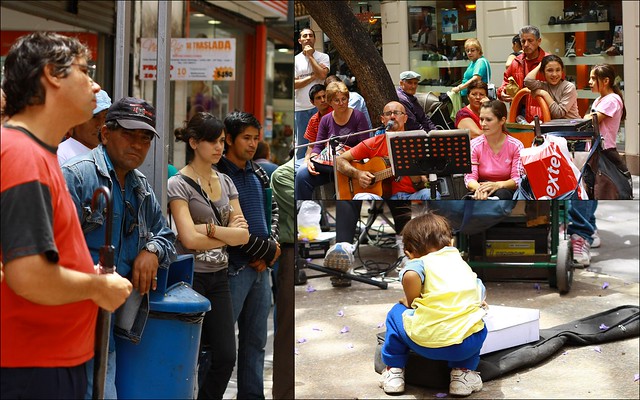
The streets were full of colours and sounds and the flowers, oh, there were flowers everywhere. I had forgotten how easy it is to buy flowers in Córdoba and how I used to get a small bouquet of jasmines every week, when coming back from work.

And the jacaranda were in full bloom reminding me of the songs of my childhood.

Córdoba is Argentina’s second biggest city but it is by no means a megalopolis such as Buenos Aires. It was founded as “Cordoba de la Nueva Andalucía” (Cordoba of the New Andalucía) in 1573 by the man in the picture below, Jerónimo Luis de Cabrera (who was probably not reading the local newspaper at that time-;) ), who was originally from Sevilla and who is said to have named the city after the one in Spain because of the similar landscape, with its surrounding hills and rivers that traverse it.
Back in those times, Córdoba was inhabited by Comechingones, from whose native language people from Cordoba are supposed to have gotten the speach trait that characterizes us and causes those from other provinces to make fun of us: the extension of the first or second syllable of a word.
The city was apparently rather small at first, until the arrival of the Jesuits, in 1599. They set up self supporting “Estancias” in other cities of the province and converted Córdoba in the heart of their evangelical mission. In 1613 Bishop Fray Fernando Trejo y Sanabria founded the University (the 2nd oldest in South America), and the Higher Schools . This lead to Córdoba being known as “La Docta” (the studious, the city of Doctors).
After the Jesuits’ expulsion by Charles III in 1767, the Franciscans took over the University and during that period was created what is today the School of Law (formerly, “Facultad de Jurisprudencia” , teaching the “Catedra de Instituta”) which signalled the introduction of non-religious studies in the curricula. The Franciscans were replaced in the direction of the University in 1808 and, after the declaration of Independence and the proclamation of the National Constitution, the University was finally nationalized in 1856.
In 1918, a revolution was initiated in the University of Córdoba, that extended to many other Universities in Latinamerica, in what is known as the “University Reform” or “University Revolution” (And let me tell you that initiating revolutions is one of the things that has always characterized my home city). This reform lead to a democratization of the curricula and, later, to the Universities autonomy and autarchy.
In the 30’s 40’s and 50’s, several companies such as FIAT and others set up factories in the city and this brought greater expansion. People (including newly arrived European immigrants) started migrating from other provinces. Unions were formed and became stronger and it was their forces, together with those of the mass of students that populated the city that lead, in 1969, to the popular revolution against the military government known as “El Cordobazo”.
Therein lies the paradox: Córdoba has historically been conservative, both politically (The Vice-king Liniers organized from it the counterevolution against the first national government, and the city and province have traditionally voted differently than the rest of the country in national elections) and religiously (There are 7 Catholic churches alone in an area of 400 m2 in the city’s downtown), yet is also a city of revolution and of change.


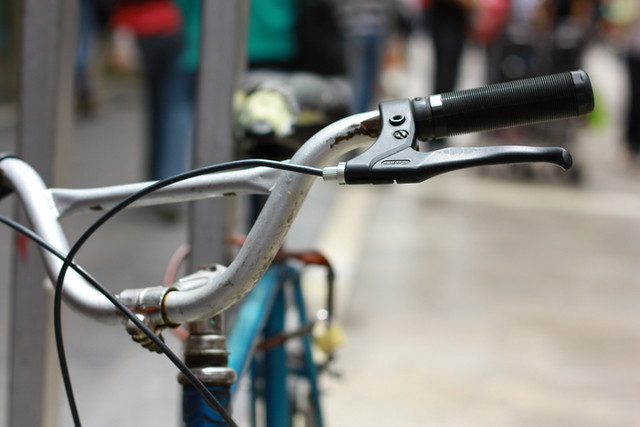
Geographically speaking, the city is a square with very distinct areas, surrounded by hills and traversed by the Suquía river. The dam that surrounds the Suquía and that was built to prevent floods constitutes the city’s most beloved landmark, La Cañada: a stonework canal, surrounded by trees that are always green and which you can see in the picture that opens this post. As for the city itself, it is mostly one of houses, not buildings, because the inner dream of all “cordobeses” (people from Cordoba) is a piece of land where to have a garden and a swimming pool to enjoy the warm months of summer.
The city’s cultural life is plentiful: there are many museums (my best friends work at the University Museum (Museo de la Manzana Jesuitica) and at the Anthropology Museum so I am a bit partial towards those two, but all of them are nice visiting), including a Children’s museum called “Museo Barrilete” which is a true delight for children of all ages. In it, children can learn about physics, play with bubbles, make their own masks, learn origami, build their own toys and even learn carpentry so, if you visit Córdoba with children, I highly encourage you to bring them to Barrilete (which means “kite”) for a wonderful afternoon. The city also has a zoo, many parks, movie theaters and frequently holds free (or very affordable) open concerts, open markets and different fairs.
In addition to this, Córdoba’s added beauty lies in the proximity of beautiful mountain villages, which are really close to the city and which are perfect for a short getaway. The province of Cordoba is divided into 5 Valleys, with beautiful landscapes, cities full of history and different traditions such as Alta Gracia, Villa General Belgrano, La Cumbre, Jesus Maria, Mina Clavero, and many others as well as fun-packed activities such as trekking, orienteering, paragliding and others. In the hills are also the old Jesuit Estancias, which are now beautiful museums where you can learn about our past, and which have been declared World Heritage by UNESCO. During the summer (January and February), there are plenty of folkloric festivals in almost every little town, as well as during Easter.

Córdoba is, for me, my first home, a place where there is always time for friends and chatter and, since this past trip it is also so much more. It is also the place where Luka and Zoe discovered the night, the moon,the stars, the joy of playing with dirt and running after dogs.
It is the place where they tried to use their first tricycle, where they enjoyed the company of little ones their own age, where they learnt to use a swing by themselves and where gardens have fairies that protect the trees.
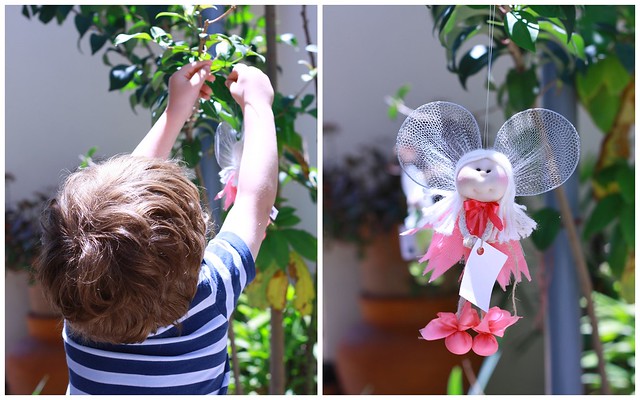
I hope that, if one day you go to Argentina, you’ll take a few days to visit Córdoba. And if you do, please drop me a line and let me know how it went. It will make me very happy.
Have a wonderful weekend!































